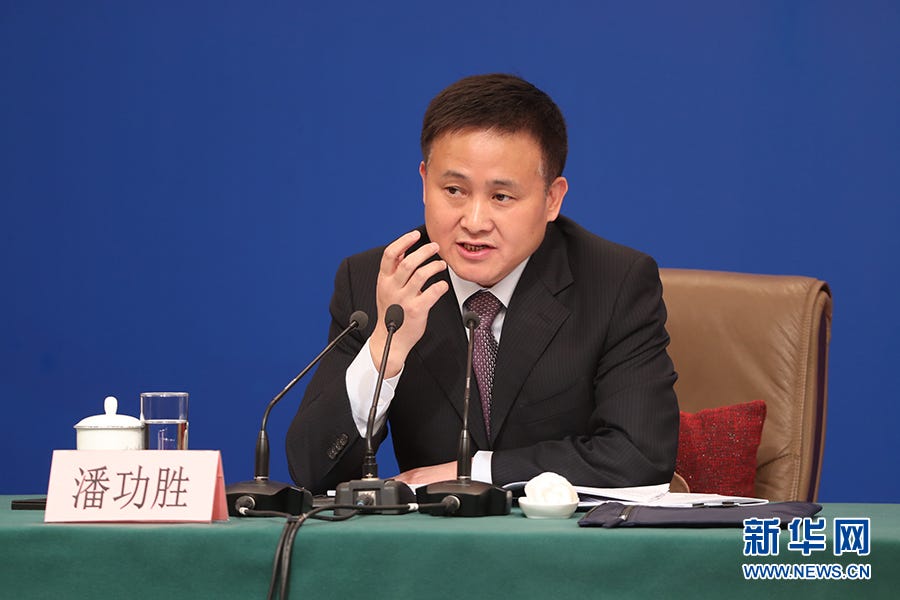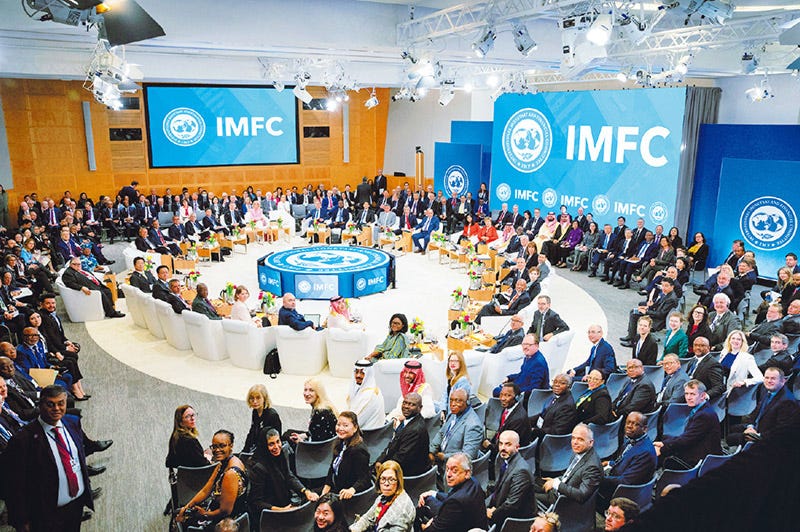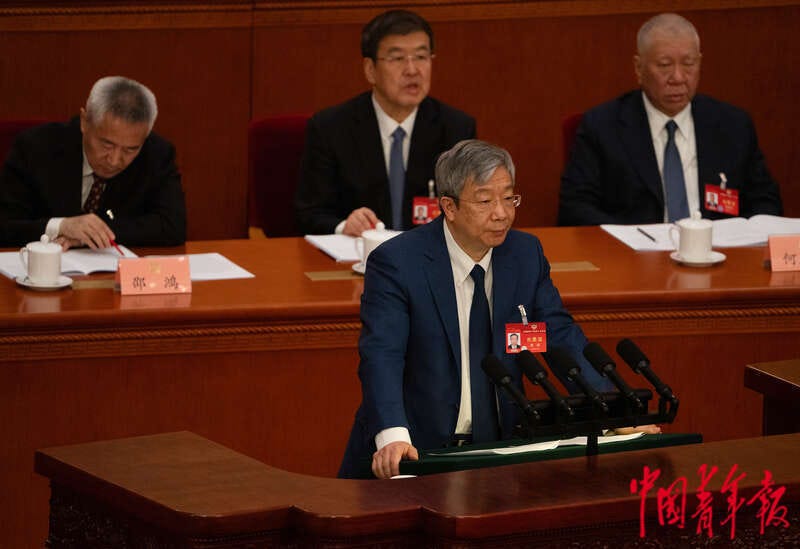Pan Gongsheng on Reforming Global Financial Governace
China’s central bank governor seeks to reduce reliance on the U.S. dollar, address risks from digital finance and geopolitical tensions, and consider IMF quota reform.
The 2025 Annual Meetings of the World Bank Group (WBG) and the International Monetary Fund (IMF) will take place in person from Monday, October 13, through Saturday, October 18 in the IMF and World Bank Group headquarters, in Washington, D.C.
The following article was published in Issue 18, 2025, of Qiushi, the official theoretical journal and news magazine of the Communist Party of China (CPC) Central Committee. It was made available on Qiushi’s official website on September 16, 2025.
Pan Gongsheng, Governor and Party Committee Secretary of the People’s Bank of China, was appointed as the head of China’s central bank in 2023.
坚定践行全球治理倡议 持续推进全球金融治理改革完善
Resolutely implement the Global Governance Initiative and Continuously Advance the Reform and Improvement of Global Financial Governance
On September 1, 2025, President Xi Jingping proposed the Global Governance Initiative (GGI) at the “Shanghai Cooperation Organization Plus” Meeting. This marks another significant contribution by China to global public goods, following the Global Development Initiative (GDI), Global Security Initiative (GSI), and Global Civilization Initiative (GCI). In his address, President Xi systematically highlighted five principles of the GGI: adhering to sovereign equality, abiding by international rule of law, practicing multilateralism, advocating the people-centered approach, and focusing on taking real actions.He addressed the critical questions of “who governs, how to govern, and governance for whom,” set against the backdrop of an escalating global governance deficit, and offered Chinese wisdom and solutions to strengthen and improve global governance.
Global financial governance is a crucial component of global governance. Currently, geopolitical conflicts are evolving, unilateralism and anti-globalization sentiments are on the rise, and the global financial governance system is undergoing rapid transformation. The guiding principles outlined in President Xi’s key speech provide a clear direction for advancing global financial governance. Given the broad scope of global financial governance, I will focus on four key areas: the international monetary system, cross-border payment systems, global financial stability, and the governance of international financial institutions. I aim to share my thoughts and reflections on how to effectively study and implement the important guiding principles outlined in President Xi Jinping’s speech on the Global Governance Initiative.
1. Promoting a New Round of Reform in the International Monetary System
Historically, the international monetary system has been in constant evolution. The shift of international dominant currencies reflects profound changes in the global landscape and is, in essence, an iteration of national competitiveness. In the 17th century, the Dutch guilder emerged as an early international currency. From the late 18th century to the first half of the 20th century, the British pound became the dominant international currency. After World War II, the U.S. dollar established its position as the leading international currency, a status that continues to this day.
An international dominant currency carries attributes of a global public good. However, relying on a sovereign currency for this role introduces inherent instabilities. F
irst, when the interests of the issuing country conflict with the currency’s role as a global public good, the issuer is likely to prioritize its own interests, thereby undermining the provision of that global public good.
Second, fiscal and financial regulatory challenges within the issuing country, coupled with accumulated structural economic imbalances, can spill over globally, leading to financial risks that may escalate into international financial crises.
Third, during times of geopolitical conflict, national security concerns, or even war, an internationally dominant currency is susceptible to being instrumentalized or weaponized.
Due to these issues, there has been growing international discourse on reforming the international monetary system. Over the past decade, the push for change was primarily driven by economic and financial considerations in the wake of the international financial crisis, and discussions were largely framed within an economic and financial context. The current wave of debate, however, is increasingly shaped by geopolitical factors. This line of discussion generally unfolds along two main directions.
The first direction is to reduce excessive reliance on a single sovereign currency and mitigate the negative impacts of such dependence, fostering healthy competition and a mechanism for incentives and constraints among a few strong sovereign currencies. Over the past two decades, the evolution of the international monetary system has displayed two key characteristics. First, the euro, introduced in 1999, has since become the second most widely used international currency after the U.S. dollar. Second, following the 2008 global financial crisis, the international status of the renminbi has steadily increased. The renminbi consistently ranks among the top three currencies in global trade financing, is the third-largest payment currency globally based on total payment volume, and holds the third-highest weight in the International Monetary Fund (IMF)’s Special Drawing Rights (SDR) basket.
The trend toward a multipolar international monetary system helps encourage sovereign currency-issuing countries to strengthen policy discipline, enhance the system’s resilience, and more effectively safeguard global economic and financial stability. In a speech delivered in May 2025, Europeen Central Bank President Christine Lagarde suggested that, amid the current geopolitical environment, the dominance of the U.S. dollar faces growing uncertainty, and the euro is expected to play a more significant role in the global monetary system. Looking ahead, the international monetary system is likely to continue evolving toward a pattern where a few sovereign currencies coexist, compete, and balance one another. Whether one or several sovereign currencies serve as the dominant international currency, the issuing countries must shoulder corresponding responsibilities by strengthening domestic fiscal discipline and financial regulation, and advancing structural economic reforms.
The second approach is to establish a supranational currency as the dominant international currency, where the IMF’s SDR being a frequently discussed option. Theoretically, the SDR could effectively address the inherent issues of relying on a single sovereign currency as the dominant international currency. It offers greater stability and is better suited to function as a global public good, able to regulate global liquidity and facilitate crisis response, making it a viable candidate for a supranational currency. However, in practice, the path to making the SDR the dominant international currency faces political challenges, including a lack of international consensus and momentum. Additionally, the current market for SDRs is limited in scale, depth, and liquidity, which restricts its functional impact. Promoting the SDR as the dominant international currency would require strong political agreement among member states, which is difficult to achieve in the current global context.
On the operational side, institutional optimization is needed to expand the use of SDRs gradually. Currently, the IMF allocates SDRs primarily for crisis response, often through one-time large-scale issuances. Moving forward, consideration should be given to regular and larger-scale SDR allocations. In terms of application, active participation from the private sector and various market entities should be encouraged. This could involve the broader use of SDRs in international trade, investment, and financing activities, the issuance of SDR-denominated bonds, enhancing the SDR’s role as a reserve asset, and establishing settlement mechanisms capable of supporting large-scale SDR usage.
2. Enhancing the Global Cross-Border Payment System
The cross-border payment system serves as the “artery” for the global flow of monetary funds. It is a critical foundation for facilitating international trade and investment, maintaining financial stability, and supporting the international monetary system. The evolution of the international monetary system towards the coexistence of a few dominant sovereign currencies, coupled with the rapid advancement of digital technologies, will drive the diversification of cross-border payment systems. In turn, this diversification will accelerate the transformation of the international monetary system.
In recent years, challenges in the traditional cross-border payment system have become increasingly apparent.
First, there is a generational gap between traditional payment methods and emerging digital technologies, leading to inefficiencies, high costs, and limited accessibility, issues that require urgent improvement.
Second, cross-border payments must navigate different legal and regulatory frameworks and engage more stakeholders, highlighting the need for stronger international cooperation. In response, international organizations like the G20 have developed specific roadmaps to enhance cross-border payments.
Third, escalating geopolitical rivalries have made traditional cross-border payment infrastructures susceptible to politicization and weaponization, often being used as tools for unilateral sanctions, thereby undermining international economic and financial order.
Against this backdrop, there is growing global demand to improve the cross-border payment system. Emerging payment infrastructures and settlement methods continue to develop, driving the global cross-border payment system toward greater efficiency, security, inclusiveness, and diversity, a trend expected to intensify in the future.
First, the cross-border payment system is diversifying. In terms of currencies, a growing number of countries and regions are adopting local currency settlements, promoting the international use of more currencies. The dominance of a single sovereign currency in cross-border payments is gradually diminishing. In terms of channels, alongside the traditional correspondent banking model, emerging cross-border payment systems and regional multilateral payment systems have emerged, offering more diverse settlement channels and further enhancing the efficiency of cross-border payments. After more than a decade of development, China has basically established a multi-channel and broadly accessible RMB cross-border payment and clearing network.
Second, the inter-operability of payment systems and ecosystems continues to improve. More countries and regions are extending payment system operating hours, adopting internationally financial messaging standards, and advancing the interconnection of fast payment systems to enhance the efficiency of cross-border payments and reduce transaction costs. In particular, several Asian countries and regions have significantly improved interoperability in retail payment ecosystems through QR code payment connectivity, greatly facilitating cross-border payments for residents.
Third, emerging technologies are accelerating their application in the cross-border payment sector. Innovations such as blockchain and distributed ledger technology are driving central bank digital currencies (CBDCs)’ development, reshaping traditional payment systems, and substantially shortening cross-border payment chains. At the same time, these advancements pose new challenges to global financial regulation and cooperation. Technologies like smart contracts and decentralized finance will also continue to propel the evolution and development of the cross-border payment system.
3. Improving the Global Financial Stability Framework
Before the 2008 international financial crisis, the international community primarily relied on the IMF-led Global Financial Safety Net (GFSN) for crisis response and post-crisis bailouts. Following the financial crisis, the international community further strengthened ex-ante preventive mechanisms such as financial regulatory rules.
On one hand, the multi-layered financial safety net has been continuously enhanced. At the global level, the IMF has consistently improved its crisis response capacity, strengthened policy oversight functions, and expanded the scope of policy supervision. At the regional level, institutions such as the European Financial Stability Facility, the Latin American Reserve Fund, the Chiang Mai Initiative, and the Arab Monetary Fund have been established, serving as critical pillars for financial stability in their respective regions. At the bilateral level, central banks of major advanced economies, including the United States, have injected liquidity into markets during crises through currency swap mechanisms. Meanwhile, local currency swap cooperation among emerging markets has been steadily advancing. The People’s Bank of China has signed bilateral local currency swap agreements with central banks or monetary authorities in over 30 countries and regions, making it an important component of the GFSN.
On the other hand, the crisis prevention system based on regulatory frameworks has been continuously improved. Following the 2008 global financial crisis, the international community undertook a series of major reforms to the global financial regulatory system, including the introduction of Basel III to enhance the resilience of banking institutions and strengthen the supervision of systemically important financial institutions (SIFIs). China has been actively involved in the formulation and implementation of international financial regulatory standards and is one of the few economies that have fully implemented Basel III. A regulatory framework for SIFIs has been established, with all of China’s systemically important banks meeting the Total Loss-absorbing Capacity (TLAC) requirements. A deposit insurance system has been put in place, providing full protection to over 99% of depositors. The new asset management rules have been introduced and fully implemented, significantly reducing risks in the shadow banking sector.
Currently, the global financial stability framework faces several new challenges. First, regulatory frameworks remain fragmented, with a tendency towards a “competitive race to the bottom.” Recently, the implementation of international regulatory standards, such as Basel III, has been influenced by domestic political factors in member countries, potentially leading to regulatory arbitrage and weakening the global financial stability system. The international community should actively implement agreed-upon regulatory reforms to prevent regulatory arbitrage and mitigate cross-border risk transmission.
Second, there is insufficient oversight in some emerging areas, such as digital finance. For instance, global regulatory coordination is lacking for rapidly expanding crypto asset markets and climate risk-related regulatory frameworks, with regulatory approaches swinging significantly and driven by overly strong political influences. The application of artificial intelligence in finance also lacks unified regulatory standards. There is a need to enhance global regulatory coordination and address gaps in financial supervision.
Third, regulation of non-bank financial intermediaries (NBFIs) remains weak. Over the past two decades, the share of NBFIs in global financing has risen significantly. Such financing tends to be less stable, less transparent, and increasingly leveraged, necessitating stronger regulation.
Looking ahead, building a diversified and efficient GFSN with a strong IMF at its core, while maintaining the consistency and authority of global financial regulatory rules, is key to preventing and resolving international economic and financial crises. This is the direction that countries and international organizations should continue to uphold and strive toward.
4. Improving International Financial Institution Governance
After World War II, starting with the IMF and the World Bank, the international community gradually established a multi‑tiered and multi‑dimensional system of international financial organizations. This system spans areas such as international policy coordination, financial regulatory rule‑making, and multilateral development institutions, serving as the primary institutional platform for international financial governance. It plays a crucial role in promoting global economic and trade growth and maintaining global financial stability.
Against the backdrop of a changing global development landscape, the shares and voting rights within major international financial institutions, such as the World Bank and the IMF, as well as some regional financial organizations, have long lacked meaningful adjustments. As a result, the representation of emerging markets and developing countries remains significantly lower than their actual weight in the global economy. The international community should also be concerned that certain member countries, driven by unilateralism, prioritize their own interests over those of international financial institutions, excessively interfering with and influencing their governance and operations. International financial institutions must keep pace with the times by advancing governance reforms that dynamically reflect member countries’ relative positions in the global economy. This includes enhancing the voice and representation of emerging markets and developing countries, upholding and practicing true multilateralism, and improving governance efficiency.
Among various international financial organizations, the IMF holds a central position and plays a crucial role in global economic and financial governance. The IMF is a quota-based institution, where the size of its quotas determines its crisis-response capacity, and the quotas of each member country dictates its voting power and financing scale. Currently, the quotas of the IMF do not adequately reflect the relative positions of member countries in the global economy. In line with the consensus already reached, expediting the adjustment of quotas is essential for the IMF to improve its governance and enhance its legitimacy and representativeness. Furthermore, while refining its governance structure, major international financial organizations should strengthen their economic and financial surveillance functions, objectively assess risks facing the globe and individual countries, and actively encourage nations to steadfastly support economic globalization and the multilateral trading system. They should also enhance policy guidance for countries, strengthen macroeconomic policy coordination, and safeguard the stability of the international financial system.
To improve global financial governance, all parties need to strengthen dialogue and cooperation. Guided by Xi Jinping Thought on Socialism with Chinese Characteristics for a New Era, the People’s Bank of China will continue to be a steadfast practitioner of the Global Governance Initiative. It will remain committed to reform and opening up and multilateralism, actively playing a leading role as a major country. The People’s Bank of China will engage in global financial governance and cooperation in a practical manner and contribute to the creation of a fairer, more just, more inclusive, and more resilient global financial governance system, contributing to better global governance.
Former PBoC Governor proposes to free up 139 billion USD for housing developers liquidity by introducing an insurance mechanism
Hi, this is Yuxuan Jia from Beijing. On March 7, during the second plenary session of the 14th National Committee of the Chinese People's Political Consultative Conference (CPPCC), Yi Gang, the former Governor of the People's Bank of China and current Deputy Director of the Economic Committee of the CPPCC National Committee











I support all the recommendations made in this article. 👏🏼👏🏼There is nothing in it that seems problematic. 🙂